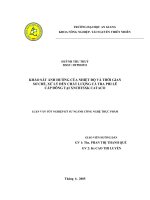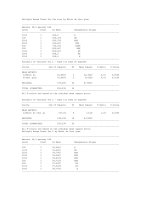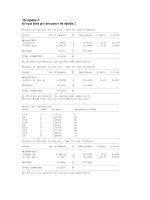ảnh hưởng của nhiệt độ và thời gian lưu trử đến tỷ lệ nảy mầm hạt moringa
Bạn đang xem bản rút gọn của tài liệu. Xem và tải ngay bản đầy đủ của tài liệu tại đây (211.79 KB, 7 trang )
ISSN: 2276-7770
Impact Factor 2012 (UJRI): 0.7904
Effect of storage
temperature and
duration on
germination of
moringa seeds
(moringa oleifera)
By
Mubvuma M. T.
Mapanda S.
Mashonjowa E.
ICV 2012: 6.15
Greener Journal of Agricultural Sciences
ISSN: 2276-7770
Vol. 3 (5), pp. 427-432, May 2013.
Research Articles
Effect of storage temperature and duration on
germination of moringa seeds (moringa oleifera)
Mubvuma M. T.1*, Mapanda S.2, and Mashonjowa E.3
1*
Faculty of Agricultural Science, Department of Soil and Plant Science. Great Zimbabwe University. P.O . Box
1235, Masvingo, Zimbabwe.
2
Food, Agriculture and Natural Resources Policy Analysis Network (FANRPAN).
3
Department of Physics, Faculty of Science, University of Zimbabwe P.O. Box MP167, Mount Pleasant, Harare,
Zimbabwe.
1*
Corresponding Author’s E-mail: , Tel +263-039 252281
ABSTRACT
Storing moringa seeds soon after harvesting at a specific storage temperature and for specific storage duration may
affect the seed quality and germination percentages of the seed. Thus, an experiment was carried out to determine
the storage temperature conditions and storage duration that may be used by small holder farmers when storing
moringa seed to achieve optimum germination percentages. The results of the study indicated that management of
storage temperature and storage duration of seed has potential to improve the seed quality and germination
percentage of moringa seed. Across all the treatments, the results suggest that the quality of the seed improves with
prolonged storage period up until three months, thereafter the quality of seed decrease with storage time unless
0
stored under low temperatures (10 C). Good germination results were achieved after storing the seeds at a storage
0
temperature of 25 C (ambient temperature) for a duration of 60 days.
Keywords: Storage temperature, storage duration, germination percentage, moringa seed.
INTRODUCTION
Moringa oleifera, also known as Horse radish, benzolive tree, kelor, marango, mlonge, moonga, mulangay,
nébéday, saijhan, sajna, Ben oil tree, or drumstick- tree (Fahey, 2005) is one of the world’s most useful and
nutritious plants (Verdcourt, 1985). The plant belongs to the moringaceae family and is indigenous to Himalayan
tracts of India, Bangladesh, Afghanistan and Pakistan (Fahey, 2005). In Zimbabwe, the plant is cultivated in
several parts of the country but mainly in the lowveld along Zambezi valley, with the highest concentration being
found in Binga district where it is known as Zakaland or Tonga by the locals (Trends, 2005; Maroyi, 2006).
Overwhelming evidence has been found that moringa has high medicinal value (Basara et al., 2011), and is
multifunctional (Anwar et al., 2007; Oduro et al., 2008). The plant has high nutritional value (Nambiar, 2006;
Thurber and Fahey, 2005), therapeutic uses (Thirusenduraselvi and Jerlin, 2007) and prophylactic properties
(Fuglie, 1999; 2000; Fahey, 2005).
Moringa is propagated sexually through seeds and vegetatively through stem cuttings (Fuglie, 1999;
Church world Service, 2000). While the stem cutting method is easy and successful for tree propagation, the
recent introduction of moringa as a field crop for biomass production requires propagation through seed (Nouman
et al., 2012). However, seed viability of the plant is low when compared to other field and horticultural crops (Croft
et al., 2012). In particular, germination percentages of moringa seed is not very good soon after harvesting of
mature seed (Maroyi, 2006). Although moringa seed does not contain any dormancy, studies on germination
percentage of fresh seed is still confusing with some studies reporting better germination percentages from fresh
seeds when compared to old seeds, whilst other studies have reported lower germination percentages on fresh
seed than on seeds that have been stored for a period of a month up until three months even under different
storage conditions (Croft et al., 2012). Germination of seed is a function of duration of storage, storage
temperature and moisture content at storage (Croft et al., 2012). Therefore, good management of storage
temperature and storage duration may enhance germination of the seed. There is need to investigate and
characterise specific storage conditions that are optimal for favourable germination percentages of moringa seed.
Such a study should focus on the development of threshold storage temperature and storage duration limits that
will allow farmers to have optimum germination percentages. This information is very important, especially to the
small holder farmers who normally retain the seed from the previous harvest and use it in the next season.
Therefore the major objective of this study was to establish storage temperature and duration threshold limits for
optimum germination of moringa seeds. The study was of the hypothesis that germination is highest within the
www.gjournals.org
427
Greener Journal of Agricultural Sciences
ISSN: 2276-7770
Vol. 3 (5), pp. 427-432, May 2013.
first three months of storage, thereafter seed germination can drop with increase in storage duration because of
changes in chemical constituents of seed cells which is expected with time. We were also of the hypothesis that
0
optimal germination for moringa is achieved when seeds are stored at relatively lower temperatures (10 C) which
preserves the seed from membrane degradation, decrease in enzyme activity and changes in chemical
constituents of seed cells.
Objectives
Overall Objective
The broad objective of the study was to improve the seed quality and germination percentages of moringa seed
through determining the optimum storage temperature and storage duration requirements that achieves a better
germination percentages.
Specific Objectives
Storing moringa seeds soon after harvesting at a specific storage temperature and for specific storage duration
may affect the seed quality and germination percentages of the seed. Now, an experiment was carried out to
determine:
•
The storage temperature conditions and storage duration that may be used by small holder farmers when
storing moringa seed to achieve optimum germination percentages.
MATERIALS AND METHODS
Study Site
The experiment was conducted at the Government Seed Testing Laboratory, Seeds Services under the
department of Research and Regulatory Services (Zimbabwe).
Experimental Design
The experiment was a factorial design laid down in a Randomized Complete Block Design with two factors
0
0
0
(storage temperature with 3 treatment levels of 10 C, 25 C, and 35 C and storage duration with 5 treatment
levels of Zero (0) days, 30 days, 60 days, 90 days and 120 days). Each treatment was replicated 3 times, giving
a total of 45 experimental units.
Treatment Development and Allocation
Soon after harvesting moringa seeds, the seeds were tested for moisture content and stored for 120 days, 90
days, 60 days, 30 days and zero days at different storage temperature conditions of 10 0 C, 25 0 C, and 35 0 C for
each storage duration. Each treatment was packed in labelled envelopes of 50 seeds each. Treatment allocation
in each plot was randomized by BSTA Statistical package (Basic statistical Analysis System -version 5).
Management of the Experiment
The experiment was conducted according to the International Seed Testing Association (ISTA, 2005) and
Association of Official Seed Analysis (AOSA, 2005). The germination substrate (sand) was first washed under
running tape water, before sterilization in an oven at a temperature of 100 0 C to control pathogens. The
germinating trays were also sterilized with liquid detergent. During planting of seeds, the seeds were tested for
moisture content, before mechanical scarification to increase water up take. The seeds were planted in sand
trays at a depth of 2 cm and in a Walk-in-germination room that had a fluctuating day and night temperature of
0
th
20/10 C respectively. The evaluation of seedlings was conducted on the 7 day and it was the first and final
counting. The seedling results were taken from visual observation and were categorized into normal and
abnormal seedlings. These normal and abnormal seedlings were then used to calculate the germination
percentages. Normal seedlings were defined as the seed that show the potential for continued development into
satisfactory plants when sown in good quality soil and under favourable conditions. Abnormal seedlings were
defined as that seed which do not show the potential for continued development into satisfactory plants when
grown in good quality soil and under favourable conditions. The abnormal seeds category also included damaged
seedlings, these were defined as seedlings with weak development or psychological disturbance or in which
essential structures are deformed or out of proportion. The data on normal and abnormal seedlings were
www.gjournals.org
428
Greener Journal of Agricultural Sciences
ISSN: 2276-7770
Vol. 3 (5), pp. 427-432, May 2013.
subjected to analysis of variance (ANOVA) using the Statistical Analysis System (SAS, 2000). Mean separation
was by Turkey’s least significant difference (LSD) at 5 % level.
RESULTS
Effect of Storage Temperature and Storage Duration on Seed Germination
The significant (P < 0.05) interaction effect of storage temperature and storage duration on germination of
moringa seeds is illustrated in table 3.1 below. For moringa seeds that were stored at a low constant temperature
0
of 10 C, significant differences (P < 0.05) were observed between seeds that were stored for a duration of 30
days and seeds that were stored for a duration of 60, 90 and 120 days. Moringa seeds that were stored at a low
0
temperature of 10 C showed an increase in germination percentage when their storage duration was increased
to 60, 90 and 120 days than when the duration was 30 days. For moringa seeds that were stored for a duration of
30 days, significant differences (P < 0.05) were observed between seeds that were stored at a temperature
conditions of 10 0 C compared with seeds that were stored at either 25 0 C or 35 0 C. Moringa seeds that were
stored at a temperature of 35 0 C showed no significant differences (P < 0.05) when the storage duration was
either 30 days, 60 days or 90 days. No differences were also significant (P < 0.05) across all temperature
treatments when the storage duration was either 60 days or 90 days. Highest germination percentages were
0
achieved for seeds that were stored at a storage temperature of 25 C, and for a storage duration of 60 days.
Table 3.1: Effect of Storage Temperature and Storage Duration on Germination of Moringa Seed
Storage
Temperature
Moisture
Content at
planting %
Storage Average
Duratio number of
n
Normal
seedlings
Average number
Of Abnormal
Seedlings
Average
number of
dead seed
Germination
%
Ambient (25 0 C)
8.85
30
20.33a
21.6
7
0
b
Ambient (25 C)
8.25
60
41.5
5
6
0
b
Ambient (25 C)
7.91
90
40.00
5
4
Ambient (25 0 C)
7.67
120
37.5b
8
6
High (35 0 C)
8.71
30
38.67 b
5.6
5.6
0
b
High (35 C)
8.18
60
41.00
3.6
5.3
0
b
High (35 C)
7.64
90
39.00
6
5
High (35 0 C)
7.55
120
27.5a
19.6
8
Low (10 0 C)
11.05
30
21.67 a
18.6
9.6
0
b
Low (10 C)
11.25
60
37.67
7.6
4.6
0
b
Low (10 C)
12.65
90
40.00
4
6
Low (10 0 C)
11.42
120
41b
5
5
Mean with the same superscripts are not significantly different at (P < 0.05).
40.66a
b
83.00
b
80.00
75.00
77.34b
b
82.00
b
78.00
a
55.00
43.34a
b
75.34
b
80.00
b
82.00
0
Lowest germination percentages were observed when the storage temperature was low (10 C) and with a short
0
storage duration of 30 days, except for seeds that were stored at a temperature of 35 C for a duration of 120
days which also recorded lower germination percentages .
www.gjournals.org
429
Greener Journal of Agricultural Sciences
ISSN: 2276-7770
25 degrees celcius
Vol. 3 (5), pp. 427-432, May 2013.
35 degrees celcius
10 degrees celcius
90
80
70
60
50
Germination %
40
30
20
10
0
30 days
60 days
90 days
120 days
Storage Duration
Fig 3.1: Germination performance of moringa seed under different storage temperature and duration.
Effect of Storage Temperature and Duration on Seed Moisture Content
Storage temperature affected seed moisture content for all the treatments under trial. Seeds that were stored at a
low temperature condition of 10 0 C had significantly higher moisture content (P<0.05) than seeds that were
0
0
stored at temperature condition of 25 C and 35 C (Fig 3.2). No differences were significant (P<0.05) in moisture
content between seeds that were stored at the same temperature treatment but varying the storage duration.
0
Seeds that were stored at a low temperature (10 C) showed an increasing trend of moisture content with
th
increase in storage duration and reached a peak value in the 90 days of storage before decreasing in the 120
0
day of storage. In some cases, the outside cover of the envelopes which contained seeds that were stored at 10
C showed few deposition of dew, although the inside of the same envelops appeared dry when viewed using
necked eye. However, seeds that were stored at a temperature of 250 C and 350 C showed a decreasing trend
of moisture content with increase in storage duration and their envelopes did not show any sign of deposition of
dew. Seed moisture content did not show any effect on germination of the seed.
25 degrees celcius
35 degrees celcius
10 degrees celcius
14
12
10
Seed moisture
content (%)
8
6
4
2
0
30 days
60 days
90 days
120 days
Storage Duration
Fig 3.2: Effect of storage temperature and duration on seed moisture content
Greener Journal of Agricultural Sciences
ISSN: 2276-7770
Vol. 3 (5), pp. 427-432, May 2013.
DISCUSSION
The results of the study indicated that management of storage temperature and storage duration of seed has
potential to improve the seed quality and germination percentage of moringa seed. Previous studies have
recommended the importance of pre-treatment of moringa seed to achieve better germination results (Nouman et
al., 2012). The germination percentages from this study compares well with findings by Muhl et al. (2011), and
this supports the reliability of the findings. The results also confirmed that moringa does not have any dormancy
since the freshly harvested seeds readily germinated after being exposed to the conditions necessary for
germination. Across all the treatments, the results suggest that the quality of the seed improves with prolonged
storage period up until three months, thereafter the quality of seed deteriorates. This observation compares well
with findings by Croft et al. (2012) and is in agreement with our study hypothesis where we expected high
germination percentages in the first three months of storage before a decrease in seed quality thereafter. This
deterioration in seed quality after three months may be a result of biochemical manifestation (Copeland, 1988),
membrane degradation (shaumugavel et al., 1995; Singh and Dadlani, 2003), decrease in enzyme activity (Perl
et al., 1978), or changes in chemical constituents of the cell (Verma et al., 2003).
Contrary to one of the study hypothesise where we expected lower temperature (10 0C) storage
conditions to maintain better viability of seed and improve the germination percentage over time, the quality of
0
seed also improved when it was stored at high temperatures (35 C). Even when the seeds were stored for a
longer duration (90 days), germination percentages remained high under high temperature conditions before
deteriorating after 120 days of storage. This quality improvement may possibly be explained by the genetic
adaptation of the seed within the centres of origin and diversity where the ambient temperature ranges between
0
0
30 C to 35 C. This high ambient temperature also improves the rate of enzymatic processes within the seed
(Vlceshouwers et al., 1995). The existence of no significant difference in germination percentages for seeds that
were stored for duration of 60 days and for 90 days across all storage temperature treatments may suggests that
there is no need to prolong the storage of the seeds to 90 days since viability would have been achieved with 60
days of storage. However, it is important to take note that viability of the seed may prolong to 90 days before
deterioration in quality starts to take place. Highest germination percentages were observed when the storage
0
0
0
temperature was either 25 C or 35 C and the storage duration was 60 days. However storing the seed at 35 C
may require additional heating equipment in seed storage rooms, especially in countries such as Zimbabwe
where the average ambient annual temperature is between 25 0 C and 30 0 C. Use of heating equipment will
increase storage costs to the farmers and is not relevant in small holder farming setup in developing world. It is
therefore suggested that farmers can still achieve good germination results after storing the seeds at a storage
0
temperature of 25 C (ambient temperature) for a duration of 60 days. However, for quick planting of seeds
which have been harvested soon, the results suggest that the seeds may need to be stored for 30 days at a
0
temperature of 35 C to give better germination results.
0
High moisture content that was observed in seeds that were stored at low temperature of 10 C may be a
result of condensation process of water vapour which takes place when seed envelop surface temperature was
lower than the surrounding air temperature (Sentelhas et al., 2004) The results also showed no effect of seed
moisture on germination percentages, and this is expected from seeds that does not contain any dormancy.
CONCLUSION AND RECOMMENDATION
Storage temperature and storage duration have an interaction effect on the germination percentages of moringa
seed. It is recommended that farmers and seed houses may store the seed for a duration of 60 days in the
0
storage room where ambient temperature is averaged at 25 C so as to achieve better germination results.
REFERENCES
Anwar F, Latif S, Ashraf M, Gilani AH (2007). Moringa oleifera: A food plant with multiple medicinal uses.
Phytother. Res. 20: 17-25.
Basra SMA, Iftikhar MN, Afzal I (2011). Potential of Moringa (moringa oleifere) Leaf Extract as Priming Agent for
hybrid Maize Seeds. International Journal of Agriculture and Biology ISSN 1814-9596.
Church World Service (2000). Moringa oleifera-the miracle tree. Church World Service. Pp3.
Croft M, Bickster A, Manson J, Burnette (2012). Vacuum Sealing vs Refrigeration: Which is the most effective
way to store seeds? Echo Asia notes. A Regional Supplement to Echo Development notes. Issue 14, 2012.
Copeland LO (1988). Seed germination. In: Prin. Seed Sci. Tech., Surjeet Publications. Delhi, pp. 55-212.
Fahey JW (2005). Moringa oleifera: A Review of the medical evidence for its Therapeutic, and prophylactic
properties. Part 1. Trees for life journal 2005, 1: 5.
www.gjournals.org
431
Greener Journal of Agricultural Sciences
ISSN: 2276-7770
Vol. 3 (5), pp. 427-432, May 2013.
Fuglie LJ (1999). The Miracle Tree: Moringa oleifera: Natural Nutrition for the Tropics. Church World Service,
Dakar. 68 pp.; revised in 2001 and published as The Miracle Tree: The Multiple Attributes of Moringa, 172
pp.
Fugile LJ (2000). Moringa oleifera- The Miracle Tree- Church World Services.
Fugile LC (2000). Moringa oleifera- The Miracle Tree- the multiple attribution of Moringa. Darkar, Senegal.
Fuglie LJ (2000). New Uses of Moringa Studied in Nicaragua. ECHO Development Notes #68, June, 2000.
Available from: />network/modules.php
Fuglie LJ (2001). The Miracle Tree. Moringa oleifera: Natural Nutrition for the Tropics. CWS, Dakar, Senegal.
pp115.
Fuglie LJ (2005). The Moringa Tree: a local solution to malnutrition? Church World Service in Senegal. pp75.
ISTA (2005). International Seed Testing Association- International Rules for seed Testing, Seed Science
Technology.
Jahn SAA (1998). Using Moringa as coagulants in developing countries, Journal Arwa management operation.
Jahn SA, Musnad HA, Burgstaller H (1986), The tree that purifies water: cultivating multipurpose Moringaceae in
the Sudan. Unasylva. 38: 23-28.
Kumur A (1976). Effect of Temperature and substratum on seed germination, India.
Martin D, Price L (2000). The Miracle Tree- Natural Nutrition for the tropics ECHO Technical notes http: /// www.
Moringa Tree orga.
Maroyi A (2006). Preliminary check list introduced and naturalized plants in Zimbabwe, kirkia, volume 18.
Muhl QE, Du toil ES, Robbertse PJ (2011). Temperature effect on seed germination and seedling growth of
Moringa oleifera Lam. Seed Science and Technology Journal Vol 39, number 1, April 2011, pp 208-213.
Murdoch AJ, Ellis RH (2000). Dormancy, viability and longetivity. In: Fenner, M. (ed.), Seeds. The ecology of
regeneration in plant communities. (2nd edition). CABI Publishing, pp. 183-214.
Nambiar VS (2006) Nutritional potential of drumstick leaves: an Indian perspective. In: Moringa and other Highly
Nutritious Plant Resources: Strategies, Standards and Markets for a Better Impact on Nutrition in Africa.
Accra, Ghana.
Nouman W, Siddiqui MT, Basra SMA, Afzal I, Rehman h (2012). Enhancement of emergence potential and stand
establishment of Moringa oleifera Lam. by seed priming. Turk. J. Agric. For. 36: 227-235.
Oduro I, Ellis WO, Owusu D (2008). Nutritional potential of two leafy vegetables: Moringa oleifera and Ipomoea
batatas leaves. Scientific Research and Essay. 3(2): 57-60.
Perl M, Luria I, Gelmond H (1978). Biochemical changes in sorghum seeds affected by accelerated ageing. J.
Exp. Bot. 29 (109): 479-509.
Sentelhas PC, Gillespie TJ, Gleason ML, Gleason ML, Monteiro JEBA, Helland ST (2004). Operational exposure
of leaf wetness sensors. Agric. For. Meteorol. 126: 59-72.
Shanmugavel S, Anuradha Varier, Malavika Dadlani (1995). Physiological attributes associated with seed ageing
in soybean (Glycine max (L.) Merrill) cultivars. Seed Res. 23(2): 61-66.
Singh KK, Dadlani M (2003). Effect of packaging on vigor and viability of soybean (Glycine max (l.) Merrill) seed
during ambient storage. Seed Res. 31(1): 27-32.
Smith MT (1992). Dormancy and Germination, Durban, South Africa.
Thirusenduraselvi D, Jerlin R (2007). Effect of Pre-germination Treatments on the emergency percentage of
Bitter Gourd cv Co1 seeds. Tropical Agricultural Research and Extension 10, 2007.
Thurber MD, Fahey JW (2009). Adoption of Moringa oleifera to combat under-nutrition viewed through the lens of
the “Diffusion of Innovations” theory. Ecol Food Nutr. 48: 212-225.
Trends (2005). Moringa, the miracle tree. Harare. Zimbabwe.
Verma SS, Tomer RPS, Urmil Verma (2003). Loss of viability and vigour in Indian mustard seeds stored under
Ambient conditions. Seed Res. 31(1): 98-101.
Verdcourt R (1985). A synopsis of the moringacea bull 44.
Vlceshouwers LM, Bouwmeester HJ, Karssen CM (1995). Redefining Seed Dormancy: an attempt to integrate
physiology and ecology. Journal of Ecology,83: 1031-1037.
www.gjournals.org
432









